English Long-faced Tumbler Pigeon Breed
Why the long face? It’s understandable if you’re confused since this pigeon is one of the most round-faced birds to ever exist.
So, it is quite reasonable to wonder how the English Long-faced Tumbler Pigeon got its name.
Its birthplace explains the pigeon’s English ancestry. It’s labeled as long-faced because of the long distance between the eyes and the wattle. And this pigeon is famous for tumbling while flying, so there’s that.
But if you’re planning to adopt some ENGLISH LONG FACED Tumblers, you need to know a little bit more. And this article is here to help you with all the information you’ll need to take care of the cute English Tumblers with the long, giant faces.
English Long-faced Tumbler Pigeon Profile
| Name | Details |
|---|---|
| Scientific Name | Columba livia |
| Common Names | English Long-face Muff Tumbler, Muffed; or English Long-face Clean-leg Tumbler, Clean-legged (depending on the variety) |
| Origin | England |
| Size | Small |
| Weight | 250-300 gms |
| Lifespan | 7-10 years |
| Physical Features | Short beak; broad distance between the eyes and the mouth; round face and body; short legs, either clean or muffed |
| Temperament | Tame; quiet |
| Behavior | Docile; gentle; social but agile |
| Special Features | Both clean-legged and muffed varieties |
| Breeding and Maintenance | Selectively bred for flight skills and display |
| Common or Popular Varieties | English Long-face Muff Tumbler; English Long-face Clean-leg Tumbler |
Interested in similar topics on pigeon breed:
Overview of English Long-Faced Tumbler Pigeons
Just like all other pigeon breeds, English Long-faced Tumbler pigeons come from the long line of Rock Dove descendants. They’re called long-faced for the long distance between the eyes and the mandible.
These pigeons have been selectively bred as domesticated fancy types since the 1800s.
They belong to the Tumbler family because of their century-long habit of tumbling while flying. These birds developed the habit of attempting to protect themselves from the claws of predatory birds.
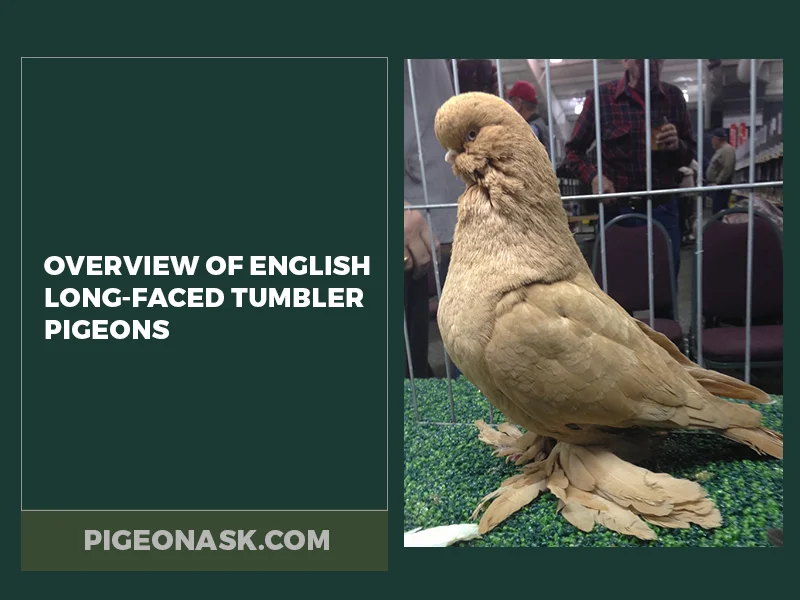
Their flight skill is what made the English Long-faced Tumbler so sought-after in Europe and the US.
As they’ve been selectively crossbred since the beginning, fanciers have always tried to add and enhance certain physical attributes to make them more presentable.
This led to the birth of two ENGLISH LONG FACED variants, those with the muffs and the other type with clean legs.
History And Origins of English Long Faced Tumbler Pigeons
To understand the history and origin of English Long-faced Tumbler Pigeons, we’ll have to go way back to the 1500s. The tumblers originally came from the East.
They were brought to Europe for show purposes; pigeon fanciers selectively crossbred the tumblers with other pigeon types to create a good-looking breed.
How They Were Bred and Developed?
During the late eighteenth and early nineteenth century, British fanciers in Birmingham developed a new breed of tumblers. These birds look and act all the same except for a slight exception in their facial features.
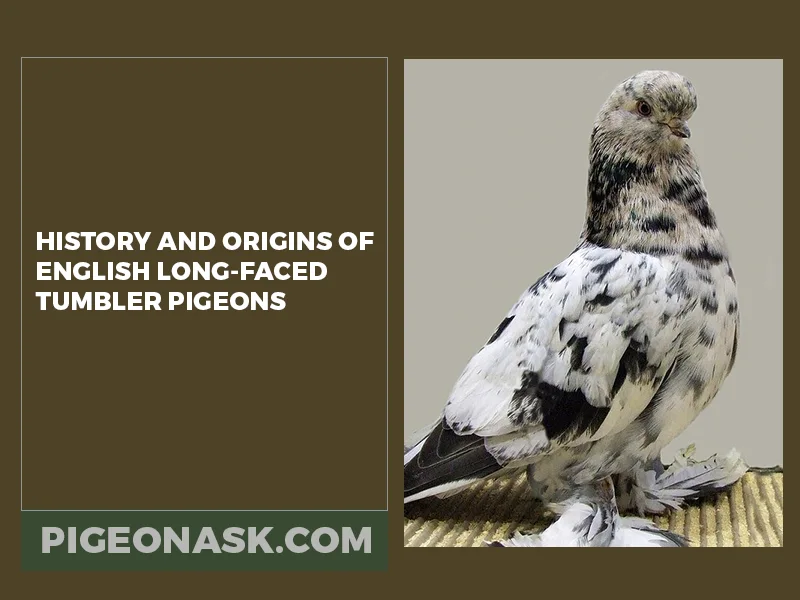
The initial breed is known as the English short-faced Tumbler and then came the Long-faced Tumbler with a greater distance between the eyes and the cere.
While short-faced Tumblers were bred strictly for display, Long-faced Tumblers became popular for their flying ability, along with their majestic appearance.
This English breed is now widely bred on the other side of the pond and has become one of the top fancy pigeon breeds in the US.
Physical Characteristics and Features
The name of the English Long-faced Tumbler gives away a few of the key physical characteristics of them. But there is still a lot in the appearance to be amazed by.
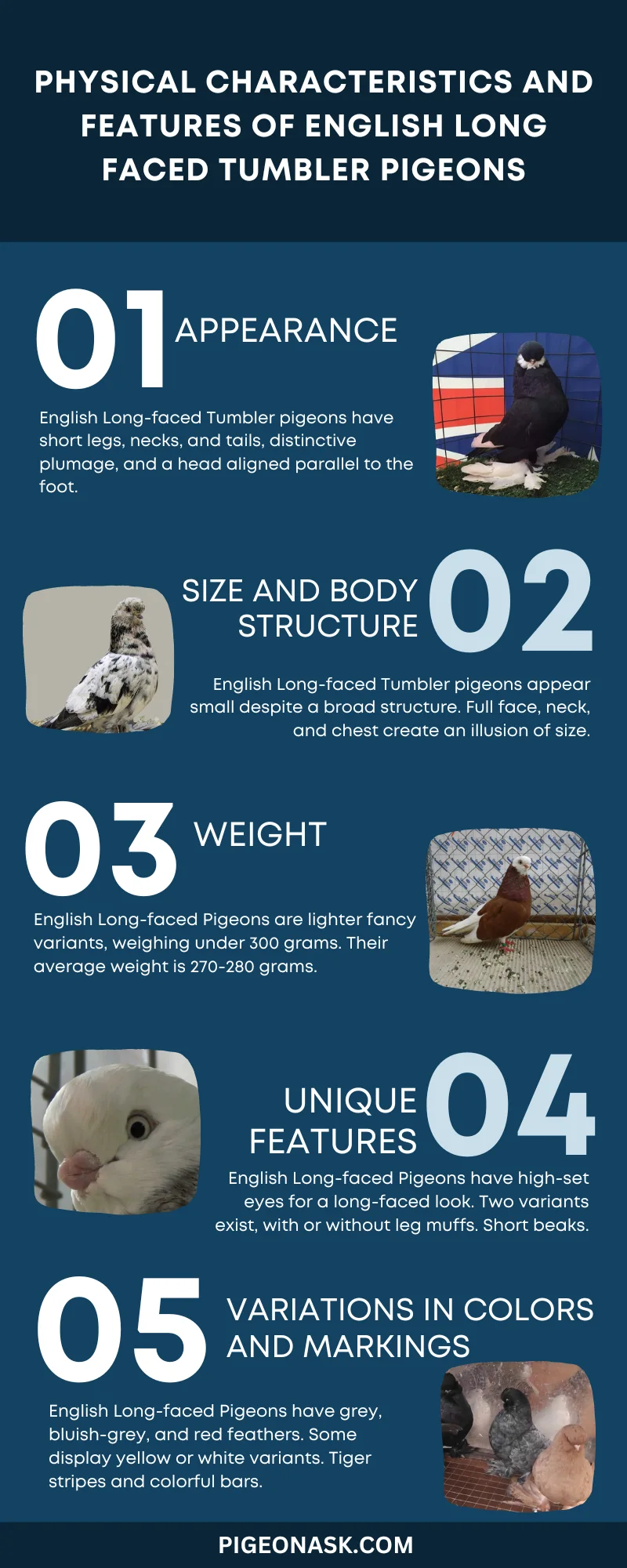
Sure, here is an updated table with more detailed physical characteristics of the English Long-Faced Tumbler:
At a glance –
| Physical Characteristic | Description |
|---|---|
| Beak | Long, thin, and straight, measuring approximately 2.5 cm in length |
| Neck | Long and thin, measuring approximately 7.5 cm in length |
| Breast | Small and prominent, with a width of approximately 4 cm |
| Legs | Long and thin, measuring approximately 7.5 cm in length. The clean legged variety has smooth, unfeathered legs, while the muffed variety has feathers covering the legs and feet. |
| Face | Long in comparison with other English show tumblers, measuring approximately 5 cm in length |
| Eye color | Usually dark, ranging from brown to black |
| Plumage | The feathers are smooth and close-fitting, with a glossy sheen. The color of the plumage can vary widely, with many different patterns and shades. |
| Tail | Short and narrow, with 12 to 14 feathers |
| Wings | Long and narrow, with a wingspan of approximately 30 cm |
Appearance
English Long-faced Tumbler pigeons’ legs, necks, and tails are shorter than those of other fancy birds bred for display. Heavily feathered and have majestic plumage, wings are compactly folded.
The head stays perfectly positioned to be parallel with the ball of the foot when standing correctly.
Size and Body Structure
These birds tend to be pretty small in size despite their broad structure. Their face, neck and chest are full, giving the illusion of ENGLISH LONG FACED pigeons being more giant than they appear to be. The head is too big in contrast to the beak.
Weight
English Long Faced Pigeon is one of the lighter, fancy pigeon variants. They don’t weigh more than 300 grams. 270-80 grams is the average weight for these pigeons.
Unique Features
Its eyes are pretty far away up from the mandible, giving it a long-faced appearance. These birds have two variants: one has muffs on its legs and the other one does not.
Beaks are too short for hunting or gathering food for baby birds.
Some Common Variation in Colors and Markings Across Different Species
Grey, bluish-grey and red are the most common feather colors in these pigeons; you might spot some yellow and white variants every now and then.
Usually features tiger stripes with about 40% white stripes. Some birds have bars with blue, green, silver, or purple sheen on their shoulders.
Distribution And Habitat of English Long Faced Tumbler Pigeons
Where they’re found the most, the name answers that quite clearly. But these pigeons aren’t confined to the borders of Great Britain, not in this age.
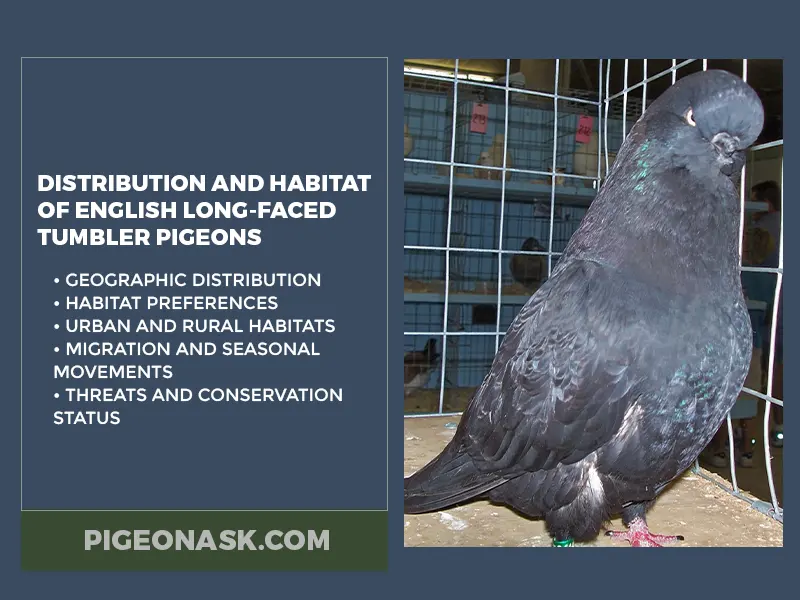
Geographic Distribution
English Long-faced Tumbler Pigeons are widely bred in the UK, as you can guess. But now it’s one of the most-demanded breeds for shows in the US.
Besides, although not for competition or display purposes, these pigeons have a big market in India, Pakistan and Bangladesh.
Habitat Preferences
These birds prefer to stay in their domestic territories out of reach of the predators.
They prefer lofts with more ventilation and walking zones. It’s better to keep the loft in a protected yet open area to allow them sufficient space for flying.
Urban and Rural Habitats
It completely depends on where the fancier intends to keep them. As these Tumblers are completely domesticated, they can adjust anywhere with a habitable loft for them nearby.
Whether it’s an urban or rural area, it’s all the same for these pigeons with the right facilities.
Migration and Seasonal Movements
Despite having a flying ability, these pigeons don’t migrate in the winter. As fanciers take care of food, shelter and nesting, English Long Faced Tumblers don’t need to move from their old places.
And given their lifestyle, these little birds wouldn’t survive a seasonal migration either way.
Threats and Conservation Status
As they’re selectively bred in significant numbers everywhere, English Long-faced Tumblers are far from disappearing anytime soon.
With all the cautious steps taken, you can keep these birds healthy and alive for a very long time. They’re mostly under threat when out in the wild.
Behavior And Traits of English Long-Faced Tumbler Pigeons
English Long-Faced Tumbler Pigeons have been brought up in a domesticated environment since birth. The process of domestication has a major influence on their personality traits and behavior in later life.
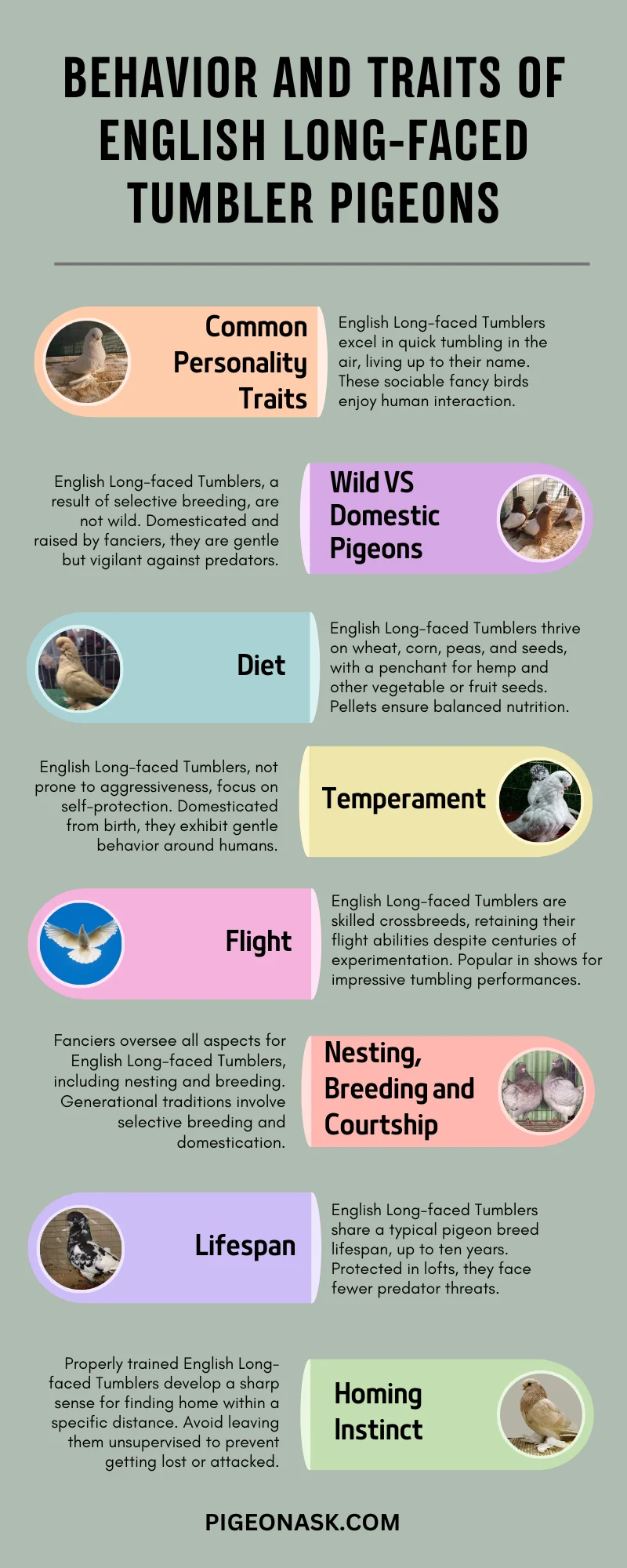
Common Personality Traits
As the name suggests, English Long-faced Tumblers are known for their quick tumbling ability when in the air. They’re one of the fancy breeds capable of flying. Sociable and friendly birds when it comes to interaction with humans.
Differences Between Wild and Domesticated Pigeons
English Long Faced tumblers aren’t wild, as they’re a byproduct of selective breeding. All of these pigeons are domesticated and brought up by fanciers in lofts.
So, they tend to be pretty gentle and tame; however, they are sharp enough to tackle danger when predatory birds are flying around.
Diet
These tumblers rely on wheat, corn, peas and seeds for their daily meals. They love to nibble on hemp and other vegetable or fruit seeds. You can always introduce your pet birds to store-bought pellets for a balanced intake of nutrition.
Temperament
As you can guess from their social attitude, these birds aren’t big on aggressiveness. They’re small and always focused on protecting themselves from bigger threats.
Because of domestication since birth, English Long Faced Tumbler pigeons grow up to behave gently in the presence of humans.
Flight
These birds are crossbreeds with a serious focus on their flying ability. It’s the English Tumbler breed that hasn’t lost the flight skill despite being experimented on with different breeds for over a century.
They’re popular in shows and competitions for their terrific performance of tumbling and twirling while flying.
Nesting, Breeding and Courtship
Fanciers take care of everything from nesting to courtship and breeding since these birds are selectively crossbred. Due to a generational tradition of selective breeding and domestication, Tumblers don’t mate by themselves.
When they’ve reached maturity, pigeons start to show signs and Fanciers do the rest.
Lifespan
Their lifespan is no different than that of other pigeon breeds. As these birds are always kept under observation in protected lofts, they’re less likely to be attacked by predators. A healthy English Long-faced Tumbler can live up to ten years.
Homing Instinct
With proper training, these Tumblers build a sharp sense of finding a home within a specific distance. However, it’s better not to leave these birds unsupervised.
These pigeons are more likely to get lost or attacked before finding their way back home because of their domesticated nature.
Breeding And Maintenance
Now comes the crucial part: breeding and maintenance. As a first-time English Long-Faced Tumbler owner, it’s important that you have a proper understanding of the breeding process and how to keep them fed and sheltered in the meantime.
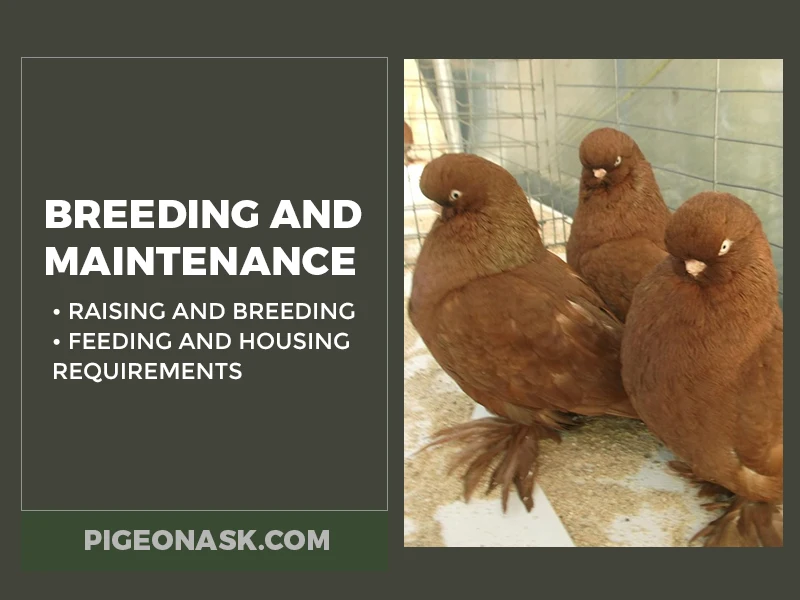
Raising and Breeding
Regarding the information about raising and breeding, you must prioritize the condition of the loft they’ll be mating in and the food. Wash the loft properly with a mixture of water and life to get rid of the pests and disinfect the entire area.
Place a box with a 6 sqft area in the breeding zone to keep the pair together. Keep them on a healthy diet of protein and carbs with peas and grains. Crushed hemp seeds and mortars will do wonders for the mother pigeon’s reproductive system.
Give them Epsom salt from time to time to ensure proper health. Once the pigeon is about to lay an egg, move them to a comfortable nest box.
Preferably a box made of wood and straws. If the mother bird is struggling to lay eggs, resort to castor oil to help them relieve the pain.
Some Tips and Considerations for Successful Breeding
Always pair them with a non-tumbling bird for breeding tumblers who are skilled flyers. People think that each bird has to be a tumbler for successful breeding, but that’s a misconception.
The birds should be checked prior to physical health if you want them to reproduce healthy babies.
Another thing, due to the extremely strong beak, it’s impossible for English Long Faced tumblers to feed baby pigeons like other birds. Fanciers bring homing pigeons into the mix to take care of this issue while bringing up baby Tumblers.
Separate them from the babies once the Long-faced squeakers are all grown up.
Feeding and Housing Requirements
When it comes to feeding and housing requirements, English Long-faced Tumbler pigeons will do just fine as long as you have a good supply of veggie protein and carbs.
Feed them corn, wheat, barley, peas and seeds on a regular basis for the needed nutrients. As a treat, give them nuts and fruits sometimes, but not daily.
Since they’re bred for show purposes or competitions and raised as fliers, you have to be pretty careful about their diet so that your Tumblers don’t gain excessive weight.
Ideally, you should feed them only two times in the span of 24 hours. If you’re worried about the proper distribution of nutrients, switch to a pellet to save yours English Long Faced pigeons the hassle.
English Long Faced Tumbler pigeons prefer the same housing as every other pigeon type. Make sure to keep the loft clean and disinfected to keep the birds healthy. Don’t use pesticides as it can be pretty detrimental to their immune system.
Final Word
Caring for English Long-faced Tumbler Pigeon is one of the easiest tasks out there. In terms of diet, breeding, and maintenance, you won’t have to do much to provide a decent environment for these birds to grow in.
However, you should always keep an eye out for cats, dogs and predatory birds when they’re out or in the sky.
But you can never have enough knowledge about pigeons, there are always some new facts to know about their lifestyle habits. Take a look at our other articles for more unexplored information on pigeons.
For future updates, follow us on Facebook, Twitter and Google News.
